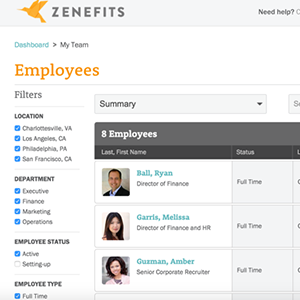 When people talk about running their business as a SaaS (Software as a Service) model that usually means the software is hosted somewhere in the cloud and they charge customers on a monthly basis for those services. One of the first companies to jump on this business model was Salesforce.com which started as a customer relationship management (CRM) tool in 1999. This allowed customers to be more flexible and buy monthly access to the software without having to purchase a software license outright that might have a large upfront cost.
When people talk about running their business as a SaaS (Software as a Service) model that usually means the software is hosted somewhere in the cloud and they charge customers on a monthly basis for those services. One of the first companies to jump on this business model was Salesforce.com which started as a customer relationship management (CRM) tool in 1999. This allowed customers to be more flexible and buy monthly access to the software without having to purchase a software license outright that might have a large upfront cost.
Then in 2006, the word “freemium” came into existence. It was first uttered on the blog of Fred Wilson, a noted venture capitalist with Union Square Ventures. From the freemium Wikipedia page:
Freemium is a pricing strategy by which a product or service (typically a digital offering or application such as software, media, games or web services) is provided free of charge, but money (premium) is charged for proprietary features, functionality, or virtual goods.
Dropbox is the poster child of this pricing strategy, they give you 2GB of free cloud storage but if you want more you have to pay for it. This strategy has worked brilliantly for 1000’s of companies and continues to be the pricing model many startups follow. From a consumer/enterprise standpoint it’s a slam dunk because you get to “try before you buy” and only when the company has proven its usefulness then you can hand over your hard earned money.
Enter 2013 and Zenefits. Since Zenefits is a business to business (B2B) offering they don’t get much mainstream media love, but they have taken the freemium SaaS model and completely blown it to bits. Zenefits is an online human resource offering which lets businesses manage their payroll and taxes, compliance, new employee onboarding, vacation tracking, time and attendance, benefits administration, stock options tracking and much more.
What makes Zenefits business model so different is that all of the features are free whether you have 5 or 1,000s of employees. In a typical freemium model they would have given away their service for free for the first 20 employees then start charging after that. So how does Zenefits makes money? They make money from a single feature – insurance. If you decide you want Zenefits to help you find and manage your insurance plans then they take a commission from that. In essence, you could use all the features (minus insurance) and never have to pay a nickel to Zenefits.
Evolution of software pricing models:
Phase 1 – Upfront site license cost and software installed on local computers (Microsoft Office)
Phase 2 – SaaS model that charges for incremental use (Salesforce)
Phase 3 – SaaS freemium model, give customers a free taste of the product (Dropbox)
Phase 4 – SaaS model that is essentially free to use without any limitations except that “one thing” (Zenefits)
I see a whole host of businesses deploying a similar pricing strategy to Zenefits. The key is to figure out that “one thing” you want to monetize which has enough margin in it. It’s the same strategy that open source companies have been using, they give away the software (like Red Hat) and then charge for that “one thing” which in this case is the service and support for Red Hat software.
Another example could be in the medical field where a doctor needs a tool for his office staff to on board new patients, book appointments, bill patients, patient records, etc… Yes, there are companies like ZocDoc and Practo that do that today with a traditional SaaS model that charge for incremental usage. But in this new model the platform would give away everything for free and monetize via the diagnostic laboratory services (i.e. blood work) that it offers. In essense, the company is really a diagnostic lab (technically known as a phlebotomy laboratory) that just happens to have a free CRM tool for the medical office. Which is really what Zenefits has done, they are an insurance broker that just happens to have an amazing set of human resource tools that companies can use.
Many people argue that when you give away something for free that no one values it…I call bullshit on that. Look no further then the current valuations of Zenefits and decide for yourself. The following quote from Chris Dixon of VC firm Andreessen Horowitz resonates with this new SaaS model:
Come for the tool, stay for the network

